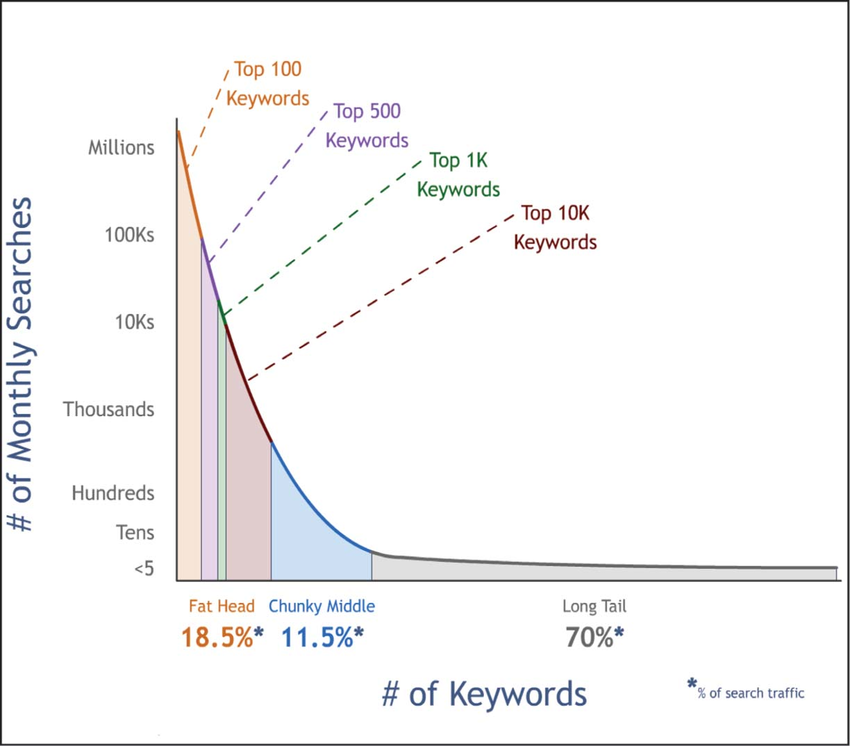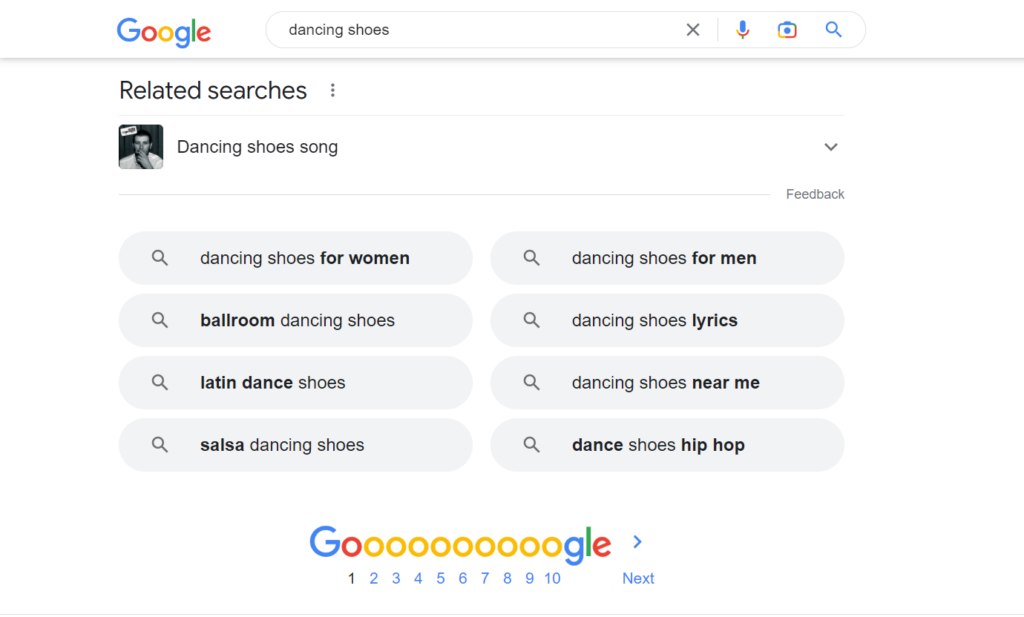Imagine you are a car dealer that sells new and used cars. A crucial way to drive traffic to your website and convert visitors to customers is by ranking for terms related to cars on SERPs.
The best search terms to rank for will be short keywords users use when intending to purchase a car. Search terms like “used cars,” “car dealership,” “new cars,” and more. However, there are thousands of car dealer websites on the internet. (Besides, some had existed before you thought of starting a car dealership.) Like you, most of these companies know the power of driving traffic by ranking for high-volume car-related searches. Maybe, some are already ranking. So how do you break into the space when the SERPs are so competitive?
This article discusses practical steps to rank for highly competitive short-tail keywords using long-tail keywords.
What Are Long-tail Keywords?
Long-tail keywords are three or more search phrases that focus on the searcher’s intent. These keywords typically have low search volume but can potentially yield a high conversion rate.
Google’s emphasis on understanding user search intent, alongside the emergence of search features such as voice search, shows that long-tail keywords are crucial these days.
Gone are the days when long-tail keywords were useless and insignificant.
According to Think with Google, “The long tail could provide an untapped opportunity to connect with potential customers. Invest in these areas and see volumes grow.
These keywords are called long-tail because of their position on the “search demand curve.” When you plot Google’s search queries for a month against their search volume, you will discover that long-tail keywords are at the “long tail” of the graph.

Figure 1Source; Researchgate
However, these keywords provide a specific conversion rate.
Why?
Long-tail keywords communicate what users are looking for on the internet. If you understand search intent, you can create content that answers these users’ queries and convert them.
For example, a user searching for a “blue 2016 Lexus GS F car” indicates a clear search intent.
On the other hand, a search term like “Lexus car” is less descriptive. The searcher might be looking for more information about the car or searching out of interest.
What Are the Differences Between Long-tail and Short-tail Keywords?
The difference between long-tail and short-tail keywords are that short-tail keywords are search phrases that contain one or two words, while long-tail keywords have three or more words.
Most importantly, short-tail keywords are used when searching for a general topic. For instance, a user new to “rank tracking” goes to Google’s search box and inputs the search term.
In contrast, a user that needs a specific result about the same query can input search terms such as “rank tracking software for eCommerce website,” “what is rank tracking?” “Free rank tracking tools,” and more. These search terms are long-tail keywords.
Short-tail keywords hold the most traffic; however, they are highly competitive. For example, the search term “rank tracking” shows millions of results, and the keyword has thousands of search volumes.
Note: It’s not impossible to rank on the first page of SERPs for short-tail keywords, but it may require a long time to fine-tune your content and build links. But if you can rank for these keywords, expect good traffic and backlinks.
As for long-tail keywords, they are more specific, less competitive, and likely to yield conversions. For example, the search term “rank tracking software for eCommerce websites” is far less competitive and more specific.
According to Think with Google, other benefits of long-tail keywords include:
- It ensures visibility when a user searches for a relevant commercial query.
- Less sophisticated advertisers often need to pay more attention to long-tail queries. They will have significantly lower costs per click due to lower auction intensity.
- Effectively maximizing long-tail keywords increases the opportunity to engage with customers and ultimately achieve your business goals.
Undeniably, short-tail keywords are worth looking into, but you need to know how to play your game well to get the best result. Optimizing your pages for long-tail queries will likely drive more traffic to your site and increase conversions.
How to Get Long-Tail Keywords
Ranking for the right long-tail keywords is similar to hitting your target in a bird shooting game. All you need is a proper keyword research strategy to discover and optimize these keywords in your content (we will discuss this at the latter end of this article).
Let’s examine a few ways to find long-tail keywords:
Use a Good Long-tail Keyword Research Tool
Several keyword research tools like keyword.com, SEMRush, Ahref, Answer the Public, Google Keyword Planner, and more ease you off the stress of searching for long-tail keywords.
These tools have built-in features that help you generate long-tail keywords with their search volumes, SEO difficulties, CTR, and more. For example, Keyword.com enables you to identify new keywords by connecting your Google Search Console account, which gives you access to suggested keywords with their referral source. Also, you can set rules for discovering new keywords.
Note: Look for keywords that contain “how,” “why,” or other words that suggest a query. This is an excellent method for finding long-tail keywords because they frequently reflect searchers’ attempts to find an answer to a topic.
Optimize Google’s Autocomplete Suggestions
Google search engine is another tool for generating long-tail keywords. All you need to do is input your seed keyword. It can be a short-tail keyword, and Google automatically creates a list of long-tail search terms.
For example, in the image above, Google automatically lists long-tail keywords for a store owner that sells baby heaters.
These keywords are search terms that reveal different users’ search intent. Creating content with each of these keywords will not just answer user queries but also potentially convert those visitors into customers.
Google’s Related Searches Suggestions
Searching on Google provides a list of related searches at the bottom of the result pages.
Now you have a list of long-tail keywords in their dozens or a few hundred.
What’s next?
Build Content around Those Long-Tail Keywords
Even though you generate thousands of long-tail keywords, not all will be useful in your SEO campaign. You need to prune your data list.
How?
Remove search terms that don’t communicate search intent. After completing this task, you have a fine-tuned keyword list ready as a battle axe.
The next step is to group these keywords based on searcher intent.
For example, if you want to target a keyword like “climbing shoes.” You have a list of long-tail keywords like climbing shoes near me, climbing shoes for women, climbing shoe sale, climbing shoes for beginners, climbing shoes for wide feet, indoor climbing shoes, climbing shoe uk, climbing shoes resole Singapore and more.
You can group these keywords into different categories, such as:
| Keywords | Intent |
| Climbing shoes near me
Climbing shoe sale |
Find cheap climbing shoes |
| Climbing shoe for beginners
Climbing shoes for wide feet Indoor climbing shoes Climbing shoes women |
Purpose of climbing shoes |
| Climbing shoe uk
climbing shoes resole Singapore |
Location of climbing shoes |
After grouping, you can create different content on your site with each search intent group.
However, you know what each content should focus on based on the intent behind the keywords.
Long-tail keyword content can aid backlink generation from many other authoritative websites and topical authority relevant to your products. These successful SEO content strategy fundamentals can eventually help you rank for more difficult short-tail keywords.
Conclusion
Backlinko says 91.8% of all search queries are long-tail keywords. You are missing out if you don’t optimize your pages with long tail keywords!
But note your long-tail keywords are only as strong as your content. You need to create content that is SEO-optimized and created to satisfy searchers’ intent.
While creating content and optimizing them with your long-tail keywords, you need to track your rankings. As you do so, you can better optimize for SEO, discover more keywords to optimize, see how your competitors perform, and more.
Keyword.com is a keyword rank tracker with a SERP tracker API that provides accurate and detailed keyword rank tracking. Most importantly, this tool offers suggested keywords to improve your ranking and your competitors’ insights to outperform them. It also offers local keyword rank tracking from any location.

